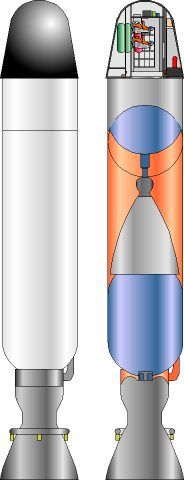
Home - Search - Browse - Alphabetic Index: 0- 1- 2- 3- 4- 5- 6- 7- 8- 9
A- B- C- D- E- F- G- H- I- J- K- L- M- N- O- P- Q- R- S- T- U- V- W- X- Y- Z
Quick Reach 2
 Quick Reach 2 Credit: Mark Wade |
Status: Design 2005. Payload: 3,700 kg (8,100 lb). Gross mass: 87,000 kg (191,000 lb). Height: 27.52 m (90.28 ft). Diameter: 4.12 m (13.51 ft). Apogee: 160 km (90 mi).
On 1 September 2004, Transformal Space Corporation LLC (t/Space) was named by NASA as one of 11 companies to conduct six-month, $ 3million studies on Crew Exploration Vehicle concepts. t/Space's partners included Burt Rutan's Scaled Composites, which had developed the Tier One system that made the first civilian spaceflight; and AirLaunch LLC, which had a unique low-cost Quick Reach rocket system under development for DARPA. t/Space was one of only two companies to receive a follow-on $ 3 million demonstration contract. Three test drops of a subscale booster in May-June 2005 proved the unique air-launch approach proposed. t/Space's partners demonstrated the technology that would ensure that it could deliver a launch system that would put the reusable CXV manned space capsule into orbit at a cost of $20 million per launch within three years of go-ahead. This was less than 10% the cost and half the time that NASA planned to spend on its own CEV approach. Naturally this was of no interest to NASA and further contracts were not forthcoming.
t/Space collaborated with Scaled Composites to design a custom Very Large Aircraft (VLA), which would carry the CXV manned space capsule and the QuickReach 2 booster to launch altitude, an extension of the White Knight design used to launch SpaceShipOne. An alternative to the VLA would be to modify and extend the landing gear of a Boeing 747 to provide sufficient ground clearance to carry the CXV and booster.
The t/Space version of air launch provided only modest performance gains compared to a ground launch (savings of 335 m/s to 550 m/s in booster delta-V requirements). The major rationale for an air launch were instead safety, simplicity and flexibility. Crew safety was enhanced because abort-at-ignition was easier when the capsule was already high enough for parachute deployment, instead of an expensive and complex on-the-pad abort tower system. Air launch allowed simpler engines in the booster, which did not have to be designed to operate at both sea-level air pressure and at altitude. Launch from 7600 m altitude permitted the engines to be run at a maximum of 10 atmospheres, which in turn meant tank pressures did not to have to exceed 14 atmospheres. This in turn meant that vapor-pressure (Vapak) pressure-feed techniques could be used, as had been demonstrate on SpaceShipOne. Vapak used the inherent vapor pressure of the propellants themselves to feed them to the pressure chamber, eliminating the need for a complex pressurization and regulation system. The coaxial pintle engine design had only one moving part downstream of the fuel and oxidizer flow valves -- there were no turbopumps or pressurization systems.
Air launch also provided better launch flexibility. Bad weather at the runway wouldn't normally delay launch. The VLA would simply fly to a launch drop point with clear weather. Air launch also allowed the launch point to match inclination and orbit phasing requirements for any particular mission. This greatly expanded the launch window compared to a fixed launch site.
The Quick Reach was a low-cost space booster already under development by AirLaunch LLC under an $11.3 million contract in Phase II of the Falcon program run by the Air Force and the Defense Advanced Research Projects Agency (DARPA). The program's goal was a booster able to loft small spacecraft for less than $5 million per launch, and with just 24-hour notice.
The Air Force / DARPA selection of AirLaunch as one three Phase II winners enabled the company to move forward on engine development and air drop techniques. The goal was a flight test of the AirLaunch QuickReach booster in 2007.
The QuickReach was a two-stage vehicle using propane and liquid oxygen. Initial tests of second stage ignition began in early May 2005.
Scale-up of the QuickReach design resulted in the Quick Reach 2 for the NASA CEV requirement.
t/Space also adopted a safer aft-crossing air-launch technique for the CXV. The new Trapeze-Lanyard Air Drop (t/LAD) method would use a mechanism to hold on to the nose of the Quick Reach 2 briefly after the booster was released, starting it rotating into a vertical position. A parachute was then used to slow the rate of rotation. A t/LAD launch eliminated the need for wings or fins on the rocket, greatly reduced ascent dynamic pressure and rocket engine thrust vectoring control, and allowed the use of the simple and very safe vapor pressurization (VAPAK) engine cycle for the launch vehicle.
Although NASA did not proceed with the low-cost concept, it certainly seemed the logical candidate for a tourist-to-orbit follow-on to Tier One.
LEO Payload: 3,700 kg (8,100 lb) to a 160 km orbit at 28.00 degrees. Launch Price $: 20.000 million in 2005 dollars.
Family: LCLVs, low cost, orbital launch vehicle. Country: USA. Spacecraft: CXV. Agency: t/Space.
Back to top of page
Home - Search - Browse - Alphabetic Index: 0- 1- 2- 3- 4- 5- 6- 7- 8- 9
A- B- C- D- E- F- G- H- I- J- K- L- M- N- O- P- Q- R- S- T- U- V- W- X- Y- Z
© 1997-2019 Mark Wade - Contact
© / Conditions for Use